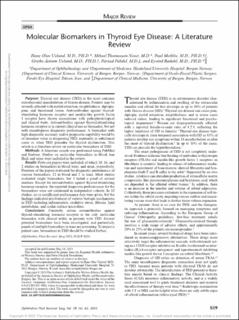| dc.description.abstract | Purpose:
Thyroid eye disease (TED) is the most common extrathyroidal manifestation of Graves disease. Patients may be severely affected with eyelid retraction, exophthalmos, diplopia, pain, and threatened vision. Autoantibodies against thyroid-stimulating hormone receptor and insulin-like growth factor 1 receptor have shown associations with pathophysiological and clinical traits. Autoantibodies against thyroid-stimulating hormone receptor is in current clinical use as biomarker, but not with unambiguous diagnostic performance. A biomarker with high diagnostic accuracy and/or prognostic capability would be of immense value in diagnosing TED, especially in subclinical cases or when TED precedes the thyroid dysfunction. This article is a literature review on molecular biomarkers of TED.
Methods:
A literature search was performed using PubMed and Embase. Studies on molecular biomarkers in blood, tear fluid, and urine were included in the review.
Results:
Forty-six papers were included, of which 30, 14, and 2 studies on biomarkers in blood, tears, and urine, respectively. Fourteen of the papers evaluated the diagnostic performance of various biomarkers, 12 in blood and 2 in tears. Most studies evaluated single biomarkers, but 3 tested a panel of several markers. Except for autoantibodies against thyroid-stimulating hormone receptor, the reported diagnostic performances for the biomarkers were not confirmed in independent cohorts. In 32 studies, no or insufficient performance data were given, but the findings indicated involvement of various biologic mechanisms in TED including inflammation, oxidative stress, fibrosis, lipid metabolism, and ocular surface microflora.
Conclusions:
Currently, serum autoantibodies against thyroid-stimulating hormone receptor is the only molecular biomarker with clinical utility in patients with TED. Several potential biomarkers have been investigated, and particularly panels of multiple biomarkers in tears are promising. To improve patient care, biomarkers in TED should be studied further. | en_US |

